National Park Track and Pack List
National Park Track and Pack List


The Most Photogenic U.S. National Parks for First-Time Visitors
Discover the most photogenic U.S. National Parks for first-time visitors from Yosemite to Zion and beyond!
Maximille Gonzales is a Northern California based photographer focused on capturing the raw & authentic – the very best of moments – out there.
His well-rounded, unique portfolio consists of moments captured from all over the world, and he uses his adventure and experience to showcase the client’s unique story that exists within.
Max has gained experiences through all of walks of life. From athletic coaching to first responding, physical therapy to programmatic marketing, international touring and backpacking to guiding and content creation. He uses his past experiences to develop his entrepreneurial mindset to create freely and to inspire frequently.
When Max is not behind the lens, you can catch him swimming, playing basketball, practicing yoga, hiking, over analyzing music and getting into adventures with his partner in crime.
Max is currently based in the San Francisco Bay Area and the greater Sacramento, CA area but is able to work worldwide.
Contact Max
Maxoutthere@Gmail.com
Bay Area, Sacramento, California, and Beyond











